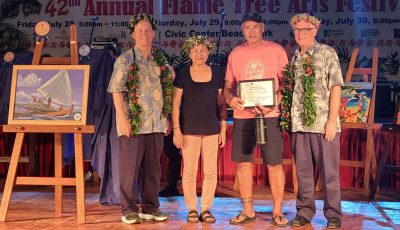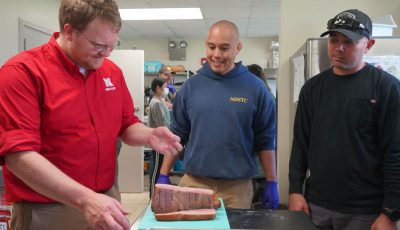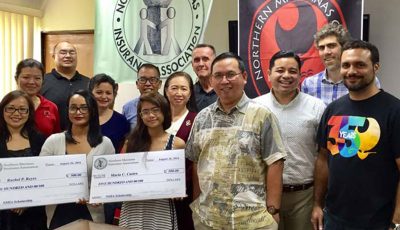Resilience, humanity after Soudelor
Typhoon Soudelor may have inflicted massive damage on Saipan with fierce winds and torrential rains but it failed to destroy people’s resilience, tenacity, hope and more importantly, their humanity.
And while the images of Soudelor’s destruction are inescapable and heart-wrenching along with signs of frustration and blaming, there are also countless heart-warming stories of determination, heroism, and kindness.
If anything, Soudelor—which later gained notoriety as the strongest storm this year so far on Earth—emboldened people’s resolve to save what can be saved from the rubble, help one another, and rebuild a community.
Saipan knows now that it is not alone in the relief and recovery efforts in the wake of the typhoon that also pounded Taiwan Saturday, leaving at least six dead, four missing, and 185 injured, before barreling on to China. Soudelor didn’t claim a single life on Saipan, but left a few with minor injuries.
Individuals, families, civic groups, local and federal government agencies, the U.S. military, private businesses and other entities within and outside Saipan, Tinian, and Rota are sending or have already sent human resources and relief supplies to Saipan to address emergency needs such as drinking water, food, power generators, utility crewmembers, toiletries, cots, and clothing.
Typhoon Soudelor, as with any disaster, brings out the best and worst in people. So far on Saipan, the typhoon has brought out the best in most people despite—or because of—the homelessness of hundreds of children and adults, the lack of water and power for thousand more, houses that in one way or another got a beating from the typhoon’s wrath, and the destruction of countless number of private and public properties.
Despite ravaging Saipan, Soudelor produced so many heroes, many of them ordinary people doing extraordinary things for others. They represent the many faces of resiliency and humanity.
They are people checking on their neighbors to see whether they’re alright, people opening their homes to others in need of shelter, people sharing their food and drinking water, neighbors clearing out common roads so they become passable once again, people helping their neighbors sift through what’s left of their houses to save what can still be saved, people helping others rebuild their homes, people driving others to check on their relatives in different neighborhoods, people helping in emergency shelters, emergency response personnel doing what they do even at the height of the typhoon, people sharing stories and photos on social media and reaching out to national news organizations to bring their attention to Saipan, people helping Saipan-bound passengers stranded in Guam or other places, people in the CNMI, Guam, Hawaii, East Coast, West Coast and other parts of the United States donating money and mobilizing people for relief efforts, and people going back to work and bouncing back as fast as they possibly can. The list goes on.
Rather than sit idle while waiting for local and federal government help to arrive, people are taking it upon themselves to reach out to villages to deliver free drinking water, food, hope, and information.
People are acting on their human instinct to help in any way they possibly can. Simple acts of greeting each other, cheering each other up, waving at each other, shaking hands, hugging and just being present for each other are keeping the spirit of community alive and strong amid the typhoon’s destruction.
“If we do a little, we can do a lot” became the mantra. Phrases such as “CNMI strong,” “Saipan strong,” “We will recover,” “God bless Saipan and the CNMI,” “Pray for Saipan,” and “Saipan you’re not alone” moved people to action. And people in other parts of the world learned about Soudelor’s devastation on Saipan, and more importantly, the tenacity of the island people brought by regional, national and international news outlets’ coverage.
This came barely a few weeks after Saipan was cut off from the rest of the world when the only undersea cable connecting the CNMI’s telecommunication to the outside world was damaged.
Most government agencies, functions and private businesses reopened a day or two after the typhoon’s direct hit, bringing a sense of normalcy amid the destruction and debris still strewn on the ground.
Acting governor Ralph DLG Torres declared a state of emergency for the entire CNMI on Monday morning. Along with Delegate Gregorio Kilili C. Sablan (Ind-MP), Torres also reached out to the White House that led to President Barack Obama’s signing of a major disaster declaration for the CNMI so that federal funds will be immediately released to help meet emergency needs and recovery efforts related to Typhoon Soudelor.
But there are also mounting frustrations and fears, along with putting the blame on the local government and federal entities for handling things differently before, during, and after the typhoon.
Questions include whether the weather forecasts, updates and warnings were insufficient, lacking or plain wrong given the typhoon’s strength and impact; whether the CNMI’s own emergency response system worked; whether top officials made the right call; whether limiting gas purchases is right under the circumstances; where are the megaphones that politicians use during election season but not during disasters to reach out to villages cut off from power, water and telecommunications; whether residents themselves put their guards down thinking Soudelor might just be like the other recent storms and typhoons that proved to be less severe than predicted.
Soudelor, just like other disasters, delivered important lessons that are not alien to many, such as taking seriously every typhoon warning, making sure backup power generators are working, making sure emergency response personnel are properly equipped and can be relied upon, and that government leaders know what they are doing. People expect their leaders to lead in calm times and in times of disaster.
But it’s also true that Soudelor’s scale and magnitude of destruction easily overwhelmed the CNMI government’s system for disaster response, and gaps in communication may have hampered immediate relief to those mostly affected. But these are learning opportunities to make the emergency response systems better and more coordinated. After immediate relief needs are met such as drinking water and food, there are also public health concerns that need to be met.
There is no perfect guidebook or instruction manual to fully prepare everyone for disasters or to rebuild after these disaster hit but Soudelor should be a driving force to invest more in sturdier houses and buildings, and strengthen critical infrastructure such as power, water and fuel facilities, among other things.
Rebuilding after a powerful typhoon such as Soudelor takes time. Sometimes it takes several weeks, months and years. But immediately looking for ways to attain some degree of normalcy and thrive under the circumstances, reaching out for help or to seek help, and having patience and faith helps lead to full recovery and rebuilding a better, stronger community.



























